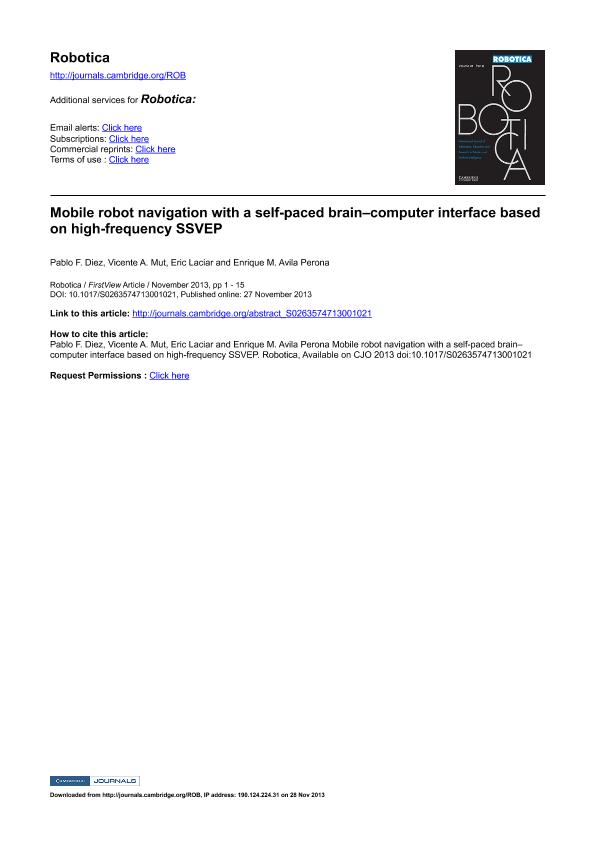Mostrar el registro sencillo del ítem
dc.contributor.author
Diez, Pablo Federico

dc.contributor.author
Mut, Vicente Antonio

dc.contributor.author
Laciar Leber, Eric

dc.contributor.author
Avila Perona, Enrique Mario

dc.date.available
2018-02-06T21:37:23Z
dc.date.issued
2013-11
dc.identifier.citation
Diez, Pablo Federico; Mut, Vicente Antonio; Laciar Leber, Eric; Avila Perona, Enrique Mario; Mobile robot navigation with a self-paced brain–computer interface based on high-frequency SSVEP; Cambridge University Press; Robotica; 32; 5; 11-2013; 695-709
dc.identifier.issn
0263-5747
dc.identifier.uri
http://hdl.handle.net/11336/35917
dc.description.abstract
A brain–computer interface (BCI) is a system for commanding a device by means of brain signals without having to move any muscle. One kind of BCI is based on Steady-State Visual Evoked Potentials (SSVEP), which are evoked visual cortex responses elicited by a twinkling light source. Stimuli can produce visual fatigue; however, it has been well established that high-frequency SSVEP (>30 Hz) does not. In this paper, a mobile robot is remotely navigated into an office environment by means of an asynchronous high-frequency SSVEP-based BCI along with the image of a video camera. This BCI uses only three electroencephalographic channels and a simple processing signal method. The robot velocity control and the avoidance obstacle algorithms are also herein described. Seven volunteers were able to drive the mobile robot towards two different places. They had to evade desks and shelves, pass through a doorway and navigate in a corridor. The system was designed so as to allow the subject to move about without restrictions, since he/she had full robot movement's control. It was concluded that the developed system allows for remote mobile robot navigation in real indoor environments using brain signals. The proposed system is easy to use and does not require any special training. The user's visual fatigue is reduced because high-frequency stimulation is employed and, furthermore, the user gazes at the stimulus only when a command must be sent to the robot.
dc.format
application/pdf
dc.language.iso
eng
dc.publisher
Cambridge University Press

dc.rights
info:eu-repo/semantics/openAccess
dc.rights.uri
https://creativecommons.org/licenses/by-nc-sa/2.5/ar/
dc.subject
Brain-Computer Interface
dc.subject
Electroencephalography
dc.subject
Man-Machine System
dc.subject
Mobile Robot
dc.subject
Steady-State Visual Evoked Potentials
dc.subject.classification
Ingeniería Médica

dc.subject.classification
Ingeniería Médica

dc.subject.classification
INGENIERÍAS Y TECNOLOGÍAS

dc.title
Mobile robot navigation with a self-paced brain–computer interface based on high-frequency SSVEP
dc.type
info:eu-repo/semantics/article
dc.type
info:ar-repo/semantics/artículo
dc.type
info:eu-repo/semantics/publishedVersion
dc.date.updated
2018-02-06T20:10:37Z
dc.journal.volume
32
dc.journal.number
5
dc.journal.pagination
695-709
dc.journal.pais
Reino Unido

dc.description.fil
Fil: Diez, Pablo Federico. Universidad Nacional de San Juan. Facultad de Ingeniería. Departamento de Electrónica y Automática. Gabinete de Tecnología Médica; Argentina. Consejo Nacional de Investigaciones Científicas y Técnicas; Argentina
dc.description.fil
Fil: Mut, Vicente Antonio. Universidad Nacional de San Juan. Facultad de Ingeniería. Instituto de Automática; Argentina. Consejo Nacional de Investigaciones Científicas y Técnicas; Argentina
dc.description.fil
Fil: Laciar Leber, Eric. Universidad Nacional de San Juan. Facultad de Ingeniería. Departamento de Electrónica y Automática. Gabinete de Tecnología Médica; Argentina. Consejo Nacional de Investigaciones Científicas y Técnicas; Argentina
dc.description.fil
Fil: Avila Perona, Enrique Mario. Universidad Nacional de San Juan. Facultad de Ingeniería. Instituto de Automática; Argentina. Consejo Nacional de Investigaciones Científicas y Técnicas; Argentina
dc.journal.title
Robotica

dc.relation.alternativeid
info:eu-repo/semantics/altIdentifier/doi/http://dx.doi.org/10.1017/S0263574713001021
dc.relation.alternativeid
info:eu-repo/semantics/altIdentifier/url/https://www.cambridge.org/core/journals/robotica/article/mobile-robot-navigation-with-a-selfpaced-braincomputer-interface-based-on-highfrequency-ssvep/7AA36DD239B3125776534C5C9214B79B
Archivos asociados
